Well, where do these engines go now?
A recent publication on the revival and development of the SSME (RS-25) engine caused the influx of lunar conspiracologists in LJ in the comments - they compared the fate of the shuttle engine to the F-1 from Saturn V. So today we will play the game “Feel like a Rocketdyne leader” and talk about the tortuous life of technology.
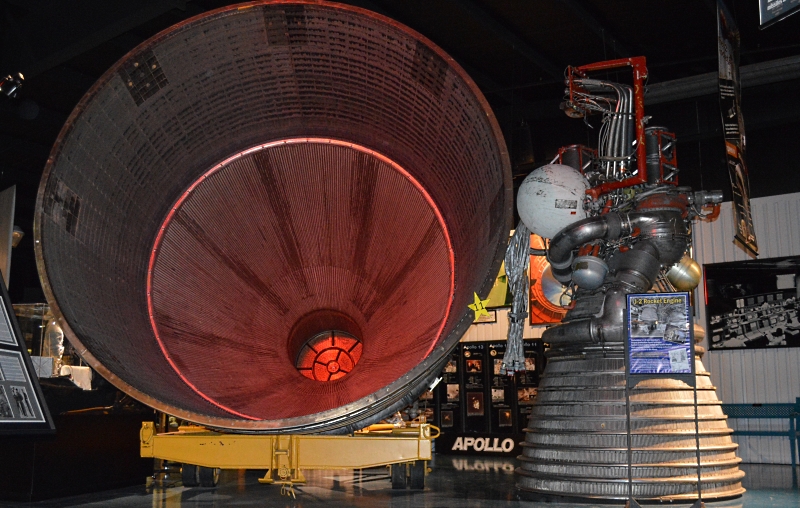
F-1 and J-2 Saturn V rocket engines at the museum
One of the “arguments” of conspiracy therapists goes something like this: “The Saturn V engines (F-1 and / or J-2) were bad, they did not achieve the desired characteristics, and after falsification of the lunar program they were quickly disposed of.” Unfortunately, very often supporters of conspiracy theories simply do not have enough knowledge - despite the fact that the engines of the lunar program did not fly after its termination, they were offered for many projects and have not completely died so far. And in order to most clearly see why they could not be attached to other rockets, let's play a mental game. So, we are the decision maker at Rocketdyne, which manufactures F-1 and J-2 engines for Saturn V.
Imagine that in the yard in 1970. In January, Apollo 20 was canceled, but soon the budget cuts reached such values that in September they had to cancel 18 and 19. The contract for 15 pieces of Saturn V is close to fulfillment, and it becomes obvious that there will be no continuation. A natural question arises - what to do?
The first option is obvious, "But let's make the Saturn V even better and try to use the engines there . " Back in the mid-60s, layouts based on Saturn V under the general name Saturn MLV (Modified Launch Vehicle, modified booster) were proposed. With boosting engines, increasing fuel supplies, adding solid fuel boosters, or replacing engines with HG-3 (RS-25 will grow from it later), various MLV options could lead from 118 to 160 tons to low orbit.
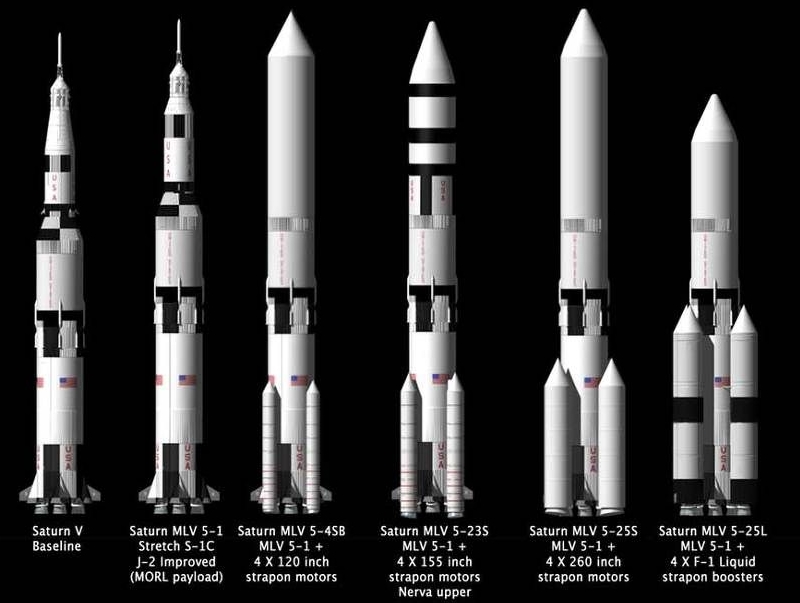
Different versions of the Saturn MLV layout are available, even with a nuclear upper stage
However, all this beauty has not caused any enthusiasm. Moreover, in April 1972 the House of Representatives of the US Congress finally makes a decision (and allocates money) for the development of the Space Shuttle. The winged spaceplane does not combine with the MLV, and the huge cost of both projects means that the money will be given only for one.
Well, the next idea is almost obvious - "And let's try to get into the project of the shuttle . " As the first stage, you can use the first stage Saturn V, and the second stage to put the outer fuel tank of the shuttle and the shuttle itself on the side. The first stage can be equipped with wings and planted back on the ground, so that the system is fully reusable. This option even has one very serious plus, which the shuttle did not have in its final version - it is possible to launch orbital station modules or other very heavy payloads in a one-time version of the second stage (load capacity ~ 100 tons), and to serve the orbital station or satellites reusable shuttle (load capacity ~ 30 tons). This is how the Saturn-Shuttle project appeared.

Start Saturn-Shuttle, NASA drawing
Alas, and here we are waiting for failure. F-1 engines were not designed for reuse, so even in the case of a soft landing, the first stage will have to be changed. And solid fuel boosters seem both simpler and cheaper, besides, they can be reused. So our first stage of the draft design competition lost.
So, we do not have “our” rocket and there is no possibility to integrate into the large project of the shuttle. And "Is it possible to put our engines on the already flying missiles" ? To answer this question, let's see what starts with the US space centers in the 1972 area.
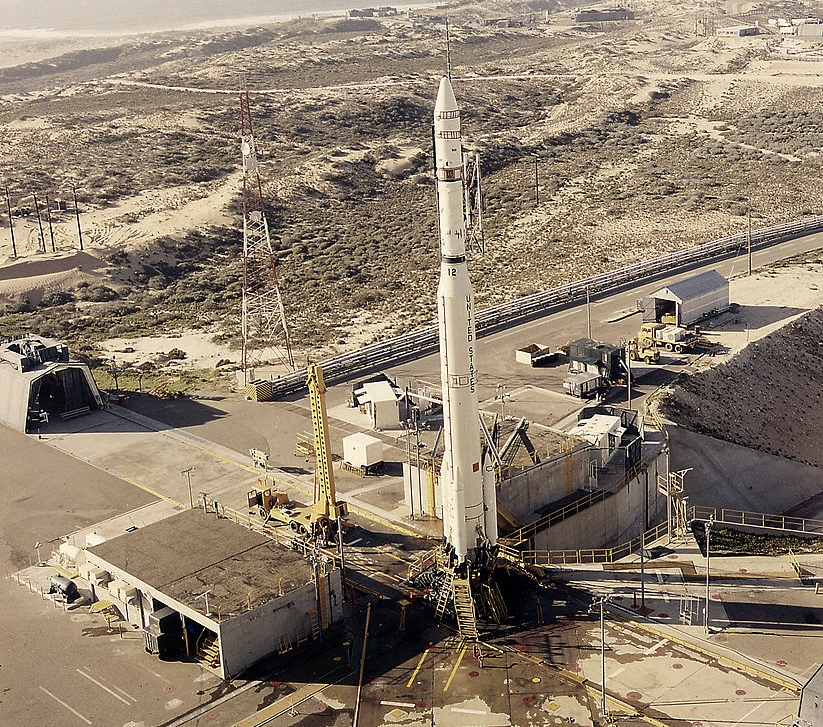
The Torah-Agen RN Thor
On the basis of the Thor ballistic missile, there are the Tor-Borner, Tor-Agena, Torad-Agena, Tor-Delta family. From it already appears the Delta family of missiles. Variants differ in upper stages and side solid fuel accelerators. And, alas, for rockets with an initial mass in the region of one hundred tons of F-1 with a load of 700 tons will not work in any way - even if it were placed in the “Torah” stage of a smaller diameter, then at the start it would provide an overload of 7 “same” breaking the rocket in the first seconds of the flight.
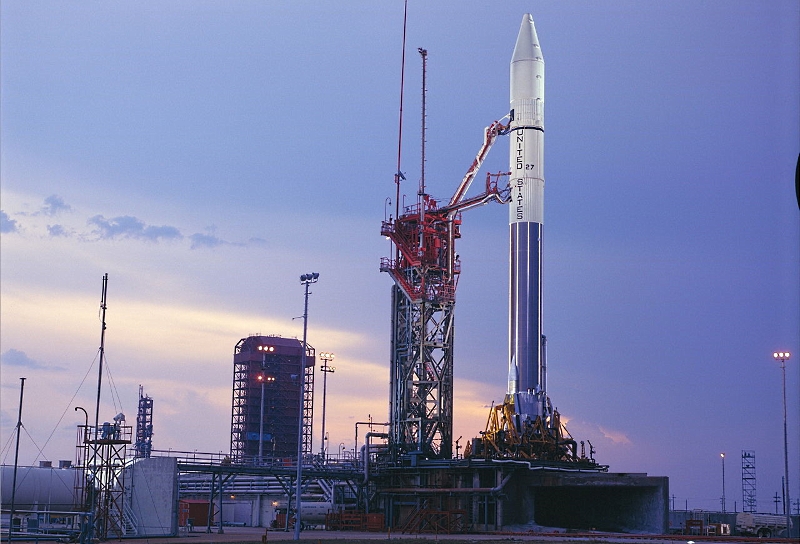
Atlas-Centaurus with Pioneer-10 interplanetary station, 1972
The Atlas RN family is a bit heavier. Here, too, there is still a variety of upper stages - Atlas-Agena, Atlas-Centaur, but even in the heaviest version, the rocket has a mass of around 150 tons, and our F-1 doesn’t fit it.

Start Titan-IIIC
And, finally, the heaviest rocket - Titan-III. The initial mass in the region of 600 tons can put as many as 13 tons into low orbit. However, here we have nothing to catch. The base engine RL-87 has a thrust in the region of 200 tons, and replacing the F-1 with 700 tons will fail not only for reasons of strength. On the central unit of Titan, another fuel is used - hydrazine and diazoto tetraoxide. And if the RL-87 was omnivorous - there were versions for oxygen / kerosene, hydrazine / AT, even oxygen / hydrogen, then nothing was known about the F-1 variants for other types of fuel. And to redesign a rocket for another fuel with an increase in tanks and the removal of side solid-fuel boosters (otherwise, again too much overload) nobody will give us money.

Overclocking block "Centaurus"
J-2 as the engine of the upper stage is also unlucky. The oxygen-hydrogen accelerating unit Centaur has already been created, but there are RL-10 engines with a load ten times less, with
more efficient ones, so there is no point in changing them to J-2. And there are no first hydrogen steps.
Curiously, a similar story occurred on the other side of the ocean, which, however, had a positive outcome - the RD-170 engine, which was developed for side accelerators, the Energiya four-chamber accelerator, so it was first cut in half, and the resulting two-chamber RD-180 was sold Americans on the first step of the grown and become more difficult "Atlas". And then again in half, putting a single-chamber RD-191 on the "Angara" and offering almost the same RD-193 for the "Union-2.1c."
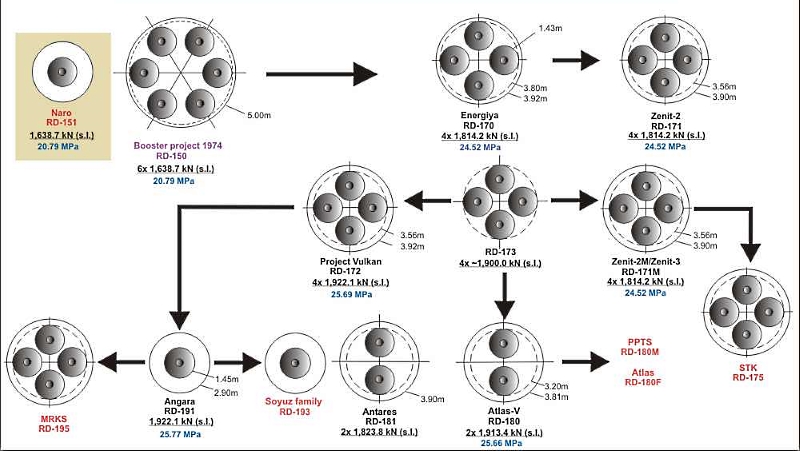
The development scheme of the family RD-170
Alas, the F-1 with J-2 are single-chamber, and we cannot reduce the size and cravings by simple and cheap actions. So we are left with only one option - to put the drawings with the engines at the warehouse, if possible, to carry out upgrades in a proactive manner and to offer them in any competition for super-heavy rockets . As practice has shown, the scheme turned out to be quite working, giving several chances (albeit not realized in the end) to return the “Apollo racers”.
J-2 got the chance first, but as a result only the name remained of him. The J-2X engine, which we first wanted to make on the J-2 base, was proposed for the Earth Departure Stage Ares block of the Ares rocket Constellation program. But because of the increased requirements, the new engine turned out, with a 30% increase in the load, on new materials and noticeably heavier.
In 2009, the Constellation program was closed, and with J-2X, the history of J-2 is being repeated. For the SLS rocket booster unit, it was considered too powerful, and one J-2X 130 tons was decided to replace 44 tons with 4 RL-10. But if the SLS needs an engine with a greater burden, the J-2X will get a new chance.
F-1 had to wait longer. He didn’t get to Constellation, but when the competition for engines for SLS was announced, hope dawned on him too. It even reached a very instructive story - the engineers got the engine number F-6049 from the warehouse, which was removed from the Saturn-5 for the Apollo-11 because of the glitch on the tests, and began to understand how it works and how it can be improved . In 2013, after decades of storage, a gas generator was tested (it drives a turbo pump that pumps fuel into the engine).
Engine, materials and methods of production of rocket engines were not in place. The new modification called F-1B should have 50 times less parts and a noticeably simplified design. For example, the exhaust of the gas generator was no longer sent to the nozzle for additional heat insulation by its curtain of excess fuel, but was banal dumped parallel to the nozzle, returning beautiful pictures of the dawn of astronautics when the flame of the gas generator hit the main exhaust .

But so far the chance has not been realized - the competition for the engines for the SLS F-1B lost and again went to the warehouse.
In the history of cosmonautics there is a case when the engines lie in the warehouse for decades and then begin to be used with minimal modifications. The remaining stock of Soviet engines NK-33 began to be put on the American Antares RN and the Russian Soyuz-2.1v. But their production will not be renewed - the credibility of the engine is undermined by the 2014 Antares accident, similar to the accident of the Soviet H-1 lunar rocket, for which NK-33 was originally made. Antares has already switched to the RD-181, and the "Union-2.1v" transition to a related RD-193 is to be after the exhaustion of the warehouse stock NK-33. Despite the fact that it is theoretically possible to resume the production of exact copies of the engines of the American lunar program, there is no practical sense in this. Technologies do not stand still - 3D printing replaces many details with one, and modern electronics are simpler and more reliable"Hydraulic logic machine" , which opens and closes the valves when the engine starts F-1. But the direct descendants of the legendary lunar engines may well return to active life, if they prove suitable for future tasks.

F-1 and J-2 Saturn V rocket engines at the museum
In someone else's skin
One of the “arguments” of conspiracy therapists goes something like this: “The Saturn V engines (F-1 and / or J-2) were bad, they did not achieve the desired characteristics, and after falsification of the lunar program they were quickly disposed of.” Unfortunately, very often supporters of conspiracy theories simply do not have enough knowledge - despite the fact that the engines of the lunar program did not fly after its termination, they were offered for many projects and have not completely died so far. And in order to most clearly see why they could not be attached to other rockets, let's play a mental game. So, we are the decision maker at Rocketdyne, which manufactures F-1 and J-2 engines for Saturn V.
Imagine that in the yard in 1970. In January, Apollo 20 was canceled, but soon the budget cuts reached such values that in September they had to cancel 18 and 19. The contract for 15 pieces of Saturn V is close to fulfillment, and it becomes obvious that there will be no continuation. A natural question arises - what to do?
Bigger and better
The first option is obvious, "But let's make the Saturn V even better and try to use the engines there . " Back in the mid-60s, layouts based on Saturn V under the general name Saturn MLV (Modified Launch Vehicle, modified booster) were proposed. With boosting engines, increasing fuel supplies, adding solid fuel boosters, or replacing engines with HG-3 (RS-25 will grow from it later), various MLV options could lead from 118 to 160 tons to low orbit.

Different versions of the Saturn MLV layout are available, even with a nuclear upper stage
However, all this beauty has not caused any enthusiasm. Moreover, in April 1972 the House of Representatives of the US Congress finally makes a decision (and allocates money) for the development of the Space Shuttle. The winged spaceplane does not combine with the MLV, and the huge cost of both projects means that the money will be given only for one.
Plan b
Well, the next idea is almost obvious - "And let's try to get into the project of the shuttle . " As the first stage, you can use the first stage Saturn V, and the second stage to put the outer fuel tank of the shuttle and the shuttle itself on the side. The first stage can be equipped with wings and planted back on the ground, so that the system is fully reusable. This option even has one very serious plus, which the shuttle did not have in its final version - it is possible to launch orbital station modules or other very heavy payloads in a one-time version of the second stage (load capacity ~ 100 tons), and to serve the orbital station or satellites reusable shuttle (load capacity ~ 30 tons). This is how the Saturn-Shuttle project appeared.

Start Saturn-Shuttle, NASA drawing
Alas, and here we are waiting for failure. F-1 engines were not designed for reuse, so even in the case of a soft landing, the first stage will have to be changed. And solid fuel boosters seem both simpler and cheaper, besides, they can be reused. So our first stage of the draft design competition lost.
At any price
So, we do not have “our” rocket and there is no possibility to integrate into the large project of the shuttle. And "Is it possible to put our engines on the already flying missiles" ? To answer this question, let's see what starts with the US space centers in the 1972 area.

The Torah-Agen RN Thor
On the basis of the Thor ballistic missile, there are the Tor-Borner, Tor-Agena, Torad-Agena, Tor-Delta family. From it already appears the Delta family of missiles. Variants differ in upper stages and side solid fuel accelerators. And, alas, for rockets with an initial mass in the region of one hundred tons of F-1 with a load of 700 tons will not work in any way - even if it were placed in the “Torah” stage of a smaller diameter, then at the start it would provide an overload of 7 “same” breaking the rocket in the first seconds of the flight.

Atlas-Centaurus with Pioneer-10 interplanetary station, 1972
The Atlas RN family is a bit heavier. Here, too, there is still a variety of upper stages - Atlas-Agena, Atlas-Centaur, but even in the heaviest version, the rocket has a mass of around 150 tons, and our F-1 doesn’t fit it.

Start Titan-IIIC
And, finally, the heaviest rocket - Titan-III. The initial mass in the region of 600 tons can put as many as 13 tons into low orbit. However, here we have nothing to catch. The base engine RL-87 has a thrust in the region of 200 tons, and replacing the F-1 with 700 tons will fail not only for reasons of strength. On the central unit of Titan, another fuel is used - hydrazine and diazoto tetraoxide. And if the RL-87 was omnivorous - there were versions for oxygen / kerosene, hydrazine / AT, even oxygen / hydrogen, then nothing was known about the F-1 variants for other types of fuel. And to redesign a rocket for another fuel with an increase in tanks and the removal of side solid-fuel boosters (otherwise, again too much overload) nobody will give us money.

Overclocking block "Centaurus"
J-2 as the engine of the upper stage is also unlucky. The oxygen-hydrogen accelerating unit Centaur has already been created, but there are RL-10 engines with a load ten times less, with
more efficient ones, so there is no point in changing them to J-2. And there are no first hydrogen steps.
Curiously, a similar story occurred on the other side of the ocean, which, however, had a positive outcome - the RD-170 engine, which was developed for side accelerators, the Energiya four-chamber accelerator, so it was first cut in half, and the resulting two-chamber RD-180 was sold Americans on the first step of the grown and become more difficult "Atlas". And then again in half, putting a single-chamber RD-191 on the "Angara" and offering almost the same RD-193 for the "Union-2.1c."

The development scheme of the family RD-170
Hibernation
Alas, the F-1 with J-2 are single-chamber, and we cannot reduce the size and cravings by simple and cheap actions. So we are left with only one option - to put the drawings with the engines at the warehouse, if possible, to carry out upgrades in a proactive manner and to offer them in any competition for super-heavy rockets . As practice has shown, the scheme turned out to be quite working, giving several chances (albeit not realized in the end) to return the “Apollo racers”.
J-2 got the chance first, but as a result only the name remained of him. The J-2X engine, which we first wanted to make on the J-2 base, was proposed for the Earth Departure Stage Ares block of the Ares rocket Constellation program. But because of the increased requirements, the new engine turned out, with a 30% increase in the load, on new materials and noticeably heavier.
In 2009, the Constellation program was closed, and with J-2X, the history of J-2 is being repeated. For the SLS rocket booster unit, it was considered too powerful, and one J-2X 130 tons was decided to replace 44 tons with 4 RL-10. But if the SLS needs an engine with a greater burden, the J-2X will get a new chance.
F-1 had to wait longer. He didn’t get to Constellation, but when the competition for engines for SLS was announced, hope dawned on him too. It even reached a very instructive story - the engineers got the engine number F-6049 from the warehouse, which was removed from the Saturn-5 for the Apollo-11 because of the glitch on the tests, and began to understand how it works and how it can be improved . In 2013, after decades of storage, a gas generator was tested (it drives a turbo pump that pumps fuel into the engine).
Engine, materials and methods of production of rocket engines were not in place. The new modification called F-1B should have 50 times less parts and a noticeably simplified design. For example, the exhaust of the gas generator was no longer sent to the nozzle for additional heat insulation by its curtain of excess fuel, but was banal dumped parallel to the nozzle, returning beautiful pictures of the dawn of astronautics when the flame of the gas generator hit the main exhaust .

But so far the chance has not been realized - the competition for the engines for the SLS F-1B lost and again went to the warehouse.
Conclusion
In the history of cosmonautics there is a case when the engines lie in the warehouse for decades and then begin to be used with minimal modifications. The remaining stock of Soviet engines NK-33 began to be put on the American Antares RN and the Russian Soyuz-2.1v. But their production will not be renewed - the credibility of the engine is undermined by the 2014 Antares accident, similar to the accident of the Soviet H-1 lunar rocket, for which NK-33 was originally made. Antares has already switched to the RD-181, and the "Union-2.1v" transition to a related RD-193 is to be after the exhaustion of the warehouse stock NK-33. Despite the fact that it is theoretically possible to resume the production of exact copies of the engines of the American lunar program, there is no practical sense in this. Technologies do not stand still - 3D printing replaces many details with one, and modern electronics are simpler and more reliable"Hydraulic logic machine" , which opens and closes the valves when the engine starts F-1. But the direct descendants of the legendary lunar engines may well return to active life, if they prove suitable for future tasks.
